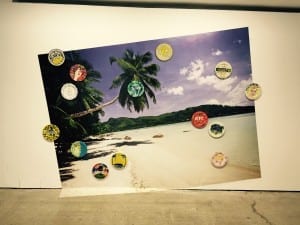In his 1932 dystopian novel Brave New World, Aldous Huxley sought to warn his fellow people of the threat that technological intervention placed on their society. Exploring a world which many would argue is already here, the innovative Prague based arts organisation DOX have taken Huxley’s vision and those of George Orwell’s 1984 and Ray Bradbury’s Fahrenheit 451 to form the exhibition Brave New World, curated by Leoš Válka and Michaela Šilpochová, which re-examines the authors’ dystopian visions and compares them to current social and political situations.
On entering the exhibition, visitors are faced with the quote “War is Peace. Freedom is Slavery. Ignorance is Strength,” taken directly from Orwell’s vision of life in a totalitarian regime. A vision turned real is illustrated by Jeremy Betham’s plans for a panopticon prision, a circular structure which enables its guards to watch all of the prison’s inmates at the same time from a central inspection house, along with photographs of the plan’s manifestation in the Cuban prison system. Opposite, a table of numbers and dates detail the death tolls of 20th century democides, reminding us of the fear and terror already inflicted by totalitarian regimes.
While Orwell’s vision was one of oppression, Huxley and Bradbury’s novels sought to illustrate the possibility of the mass manipulation of people through a state of voluntary slavery. Artists Paolo Cirio and Alessandro Ludovico’s Face to Facebook project, a fake dating site of profiles created using information pooled from random Facebook accounts, highlights the possible consequences of voluntarily sharing personal data online. Advertising and media agencies also manipulate willingly shared data to assist the creation of their powerful and sustained campaigns, but when the technology bombardment all gets too much, Kristof Kintera’s Plumbuman – a space-age metal-box providing a protective haven for the individual seeking isolation from all forms of ‘civilization contamination’ – is there to cater to your needs.
The upper floor of the exhibition translates the novels’ visions into the current day by looking at society’s ‘drop outs’, such as Japan’s hikikimori, who isolate themselves from the pressures of society. In a live installation created by the Farm in a Cave theatre troop, people sleep in Perspex boxes isolated from the outer world, studied by those who pass as if their need for isolation is an unnatural occurrence. Also accessible from the upper level is a site specific interactive installation created entirely from adhesive tape by the NUMEN/FOR USE group. A large bubble-like form which floats six metres above the lower gallery with one entrance and exit and several dead-ends, it is perhaps a metaphor for birth, death and the pointlessness of a life lived under state controlled, voluntary slavery.
Finally, the audience are drawn through to a tower of small amassed gallery spaces containing the installation Absolute Happiness, a specially designed collaborative installation created by artist Jens Hikel and curator Leoš Válka. A manifestation of Huxley’s vision of a predestination centre where the quality and quantity of the human population is controlled, clear tubes run through all three floors sucking plastic baby dolls up and down the numerous levels while machinery whirrs away ominously in the background; a disturbing yet fascinating look at possible consequences of genetic engineering.
Brave New World ponders Orwell, Huxley and Bradbury’s past dystopian visions, highlighting historical examples of the devastating effect that totalitarianism can have and how society’s ‘drop-outs’ are inadvertently treated for their differences. Raising issues via current day examples that the visitor might have previously overlooked, the show is yet another example of DOX’s innovative and challenging exhibition programme. DOX is forging its own direction in curation, shifting the focus from the aesthetic and bringing the provocation of discussion and art’s ability to foment change to the fore.
Emma Sumner
Brave New World, until 25 January, DOX Centre for Contemporary Art, Prague.
Learn more at www.dox.cz.
Follow us on Twitter @AestheticaMag for the latest news in contemporary art and culture.
Credits
1. Installation view of Brave New World, 2015. Courtesy of DOX Centre for Contemporary Art.





